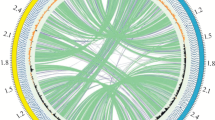Abstract
A new methanogenic isolate termed JC3 is described. It is aMethanosarcina as demonstrated by morphologic (light and electron microscopy), physiologic, and DNA characteristics. It belongs to the speciesM. mazie according to DNA-base composition, DNA-DNA homology, and antibiotic sensitivity spectrum. JC3 can be considered a newM mazei strain, since it differs from other well-characterized strains of this species in the following phenotypic features: conversion from packets to single cells, lamina formation, antigenic fingerprint of whole cells, and antigen pattern (immunoblot) of cell extracts.
Similar content being viewed by others
Literature Cited
Aldrich HC, Robinson RW, Williams DS (1986) Ultrastructure ofMethanosarcina mazei. Syst Appl Microbiol 7:314–319
Anderson TF (1951) Techniques for the preservation of three dimensional structures in preparing specimens for electron microscopy. New York: Trans NY Acad Sci 13:130–139
Boone DA, Math RA (1989) Methanosarcinaceae. In: Holt JG, Staley JT (eds) Bergey's manual of systematic bacteriology, vol 3. Baltimore: Williams and Wilkins, pp 2198–2216
Boone DR, Whitman WB (1988) Proposal of minimal standards for describing new taxa of methanogenic bacteria. Int J Syst Bacteriol 38:212–219
Cairó J, Macario, AJL, Bardulet M, Conway de Macario E, París JM (1991) Psychrophilic ecosystems of interest for wastewater treatment: microbiologic and immunologic elucidation of their methanogenic flora. Syst Appl Microbiol 14:85–92
Gander JE (1984) Gel protein stains: glycoproteins. Methods Enzymol 104:447–448
Gersten DM, Wolf PH, Zapolski EJ (1987) Differences in protein staining by Coomassie brilliant blue and neutron activated Coomassie brilliant blue dyes. Electrophoresis 8:545–551
Glauert AM, Glauert RH (1958) Araldite as an embedding medium for electron microscopy. J Biophys Biochem Cytol 4:409–414
Harris JE (1987) Spontaneous disaggregation ofMethanosarcina mazei S-6 and its use in the development of genetic techniques forMethanosarcina spp. Appl Environ Microbiol 53:2500–2504
Hilpert R, Winter J, Hammes W, Kandler O (1981) The sensitivity of archaebacteria to antibiotics. Zbl Bakt Hyg, I Abt Orig C2:11–20
Hungate RE (1969) A roll tube method for cultivation of strict anaerobes. In: Norris JR, Ribbons DW (eds) Methods in Microbiology, vol 3B. New York: Academic Press, pp 117–132
Jarrell KF, Hamilton EA (1985) Effect of gramicidin on methanogenesis by various methanogenic bacteria. Appl Environ Microbiol 50:179–182
Jarrell KF, Kalmokoff ML (1988) Nutritional requirements of the methanogenic archaebacteria. Can J Microbiol 34:557–576
Laemmli UK (1970) Cleavage of structural proteins during the assembly of the head of bacteriophage T4. Nature 227:680–685
Liu Y, Boone DR, Sleat R, Mah RA (1985)Methanosarcina mazei LYC, a new methanogenic isolate which produces a disaggregating enzyme. Appl Environ Microbiol 49:608–613
Macario AJL, Conway de Macario E (1983) Antigenic fingerprinting of methanogenic bacteria with polyclonal antibody probes. Syst Appl Microbiol 4:451–458
Macario AJL, Conway de Macario E (1985) Antibodies for methanogenic biotechnology. Trends Biotechnol 3(8):204–208
Macario AJL, Conway de Macario E (1985) Monoclonal antibodies of predefined molecular specificity for identification and classification of methanogens and for probing their ecologic niches. In: Macario AJL, Conway de Macario E (eds) Monoclonal antibodies against bacteria, vol II. Orlando: Academic Press, pp 213–217
Maestrojuán GM, Boone DR (1991) Characterization ofMethanosarcina barkeri MST and 227,Methanosarcina mazei S-6T, andMethanosarcina vacuolata Z-761T. Int J Syst Bacteriol 41:267–274
Mah RA (1980) Isolation and characterization ofMethanococcus mazei. Curr Microbiol 3:321–326
Mah RA, Smith MR, Baresi L (1978) Studies on an acetatefermenting strain ofMethanosarcina. Appl Environ Microbiol 35:1174–1184
Mayerhofer LE, Macario AJL, Conway de Macario E (1992) Lamina, a novel multicellular form ofMethanosarcina mazei S-6. J Bacteriol 174:3009–3014
Miller TL, Wolin MJ (1974) A serum bottle modification of the Hungate technique for cultivating obligate anaerobes. Appl Environ Microbiol 27:985–987
Pecher T, Böck A (1981) In vivo susceptibility of halophilic and methanogenic organisms to protein synthesis inhibitors. FEMS Microbiol Lett 10:295–297
Robinson RW (1986) Life cycles in the methanogenic archaebacteriumMethanosarcina mazei. Appl Environ Microbiol 52:17–27
Robinson RW, Aldrich HC, Hurst SF, Bleiweis AS (1985) Role of the cell surface ofMethanosarcina mazei in cell aggregation. Appl Environ Microbiol 49:321–327
Scherer PA, Bochem HP (1983) Ultrastructure investigation of 12Methanosarcinae and related species grown on methanol for occurrence of polyphosphatelike bodies. Can J Microbiol 29:1190–1199
Segrest JP, Jackson RL (1972) Molecular weight determination of glycoproteins by polyacrylamide gel electrophoresis in sodium dodecyl sulfate. Methods Enzymol 28:54–63
Sowers KR, Gunsalus RP (1988) Adaptation for growth at various saline concentrations by the archaebacteriumMethanosarcina thermophila. J Bacteriol 170:998–1002
Touzel JP, Albagnac G (1983) Isolation and characterization ofMethanococcus mazei strain MC3. FEMS Microbiol Lett 16:241–245
Towbin H, Gordon J (1984) Immunoblotting and dot immunobinding—current status and outlook. J Immunol Methods 72:313–340
Winfrey MR (1984) Microbial production of methane. In: Atlas RM (ed) Petroleum microbiology. New York: Macmillan, pp 153–219
Woese CR, Kandler O, Wheelis MC (1990) Towards a natural system of organisms: proposal for the domains Archaea, Bacteria and Eucarya. Proc Natl Acad Sci USA 87:4576–4579
Xun L, Boone DR, Mah RA (1988) Control of the life cycle ofMethanosarcina mazei S-6 by manipulation of growth conditions. Appl Environ Microbiol 154:2064–2068
Zehnder AJB, Ingvorsen K, Marti T (1982) Microbiology of methane bacteria. In: Hughes DE, Stafford DA, Wheatly BI, Baader W, Lettinga G, Nyns EJ, Verstraete W, Wentworth RL (eds) Anaerobic digestion 1981. New York: Elsevier Biomedical Press, pp 45–68
Author information
Authors and Affiliations
Additional information
Deceased.
Rights and permissions
About this article
Cite this article
Clarens, M., Cairó, J.J., París, J.M. et al. Characterization and forms of JC3, a newMethanoarcina isolate: Comparison withMethanosarcina mazei strains S-6T MC3, and LYC. Current Microbiology 26, 167–174 (1993). https://doi.org/10.1007/BF01577373
Issue Date:
DOI: https://doi.org/10.1007/BF01577373




